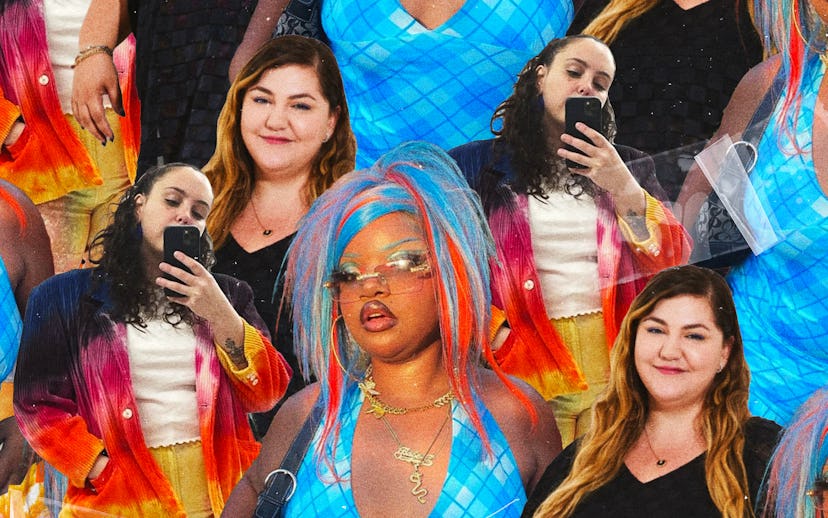
Beauty
Meet The Influencers Leading the Size Inclusive Y2K Trend Revival
These creatives are reclaiming the 2000s aesthetic for a new era and new attitudes.
At this moment in the fashion and beauty industry, it feels like we’ve all unknowingly stepped into a time machine and landed in 2002. It seems like every day a new trend from the decade is returning, including butterfly clips, chunky highlights, and even stretch comb headbands. From Bella Hadid’s skinny eyebrows to Rihanna’s new horizontal highlights, to everybody in bucket hats. Y2K style is back in full swing. And while many trends have been generally fun to see again, others come back accompanied by mixed emotions. Some trends, like low-rise jeans, are equally as divisive today as they were 20 years ago.
The glittery and bedazzled nature of the 2000s, makes it easy to forget that the decade had an enormous issue with glamorizing pro-anorexia body standards. In fact, Y2K nostalgic content on Gen Z platforms is already once again falling into the trap of associating Y2K culture with extreme thinness. With eating disorders currently on the rise, it seems like the revival has the potential to set back some of the progress the industry has made in regard to size inclusivity. So is it possible to celebrate the decade without perpetuating thinness? 18-year-old Y2K beauty influencer Tiaynna McClyde says so.
McClyde is one of the many plus-size creators reclaiming the Y2K revival, with over 80-thousand followers on Instagram staying up-to-date with her creative takes on 2000s beauty trends like two-toned hair, thin eyebrows, and blue eyeshadow. “I remember seeing how popular Y2K aesthetic was becoming but not seeing one plus-size person,” McClyde told NYLON. “It was so unsatisfying because it made me and others I know feel like we have to lose weight to buy Y2K clothes.”
McClyde is purposely carving a space for other plus-size people to take part in Y2K trends, so they don’t feel the same way about the generally noninclusive era’s fashion revival in 2022. “I love so much to see a black, phat (pretty, hot, and thick), fem people in Y2K looks because the aesthetic is not just about putting on layers of clothes, it’s about being confident and wearing so many accessories,” they say. McClyde’s favorite Y2K beauty trends are “cyber-punk” and “the auntie hoochie mama” (think glammed-up and in a micro-mini skirt) because it reminds her of the ’90s and ’00s television shows she watched growing up. Drawing outfit inspiration from the past, McClyde’s Instagram shows off them wearing mesh tops, fluffy hats, and miniskirts with large hoop earrings and colorful eyeshadow.
Tamara Malas, the founder of her eponymous plus-size clothing brand, says she’s seen many customers looking to engage with more inclusive Y2K trends. “When I think Y2K my brain immediately takes me to childhood, spending weekends at the local mall browsing Limited Too and watching Zenon Girl of the 21st Century,” she says. “But that time period celebrated the polar opposite of inclusivity. These days I’m so thankful that individuality is a lot more celebrated and embraced.” Malas is most excited about Y2K nail art, saying she is “obsessed with the process and love the concept of wearable art on your fingertips that takes 2-3 hours to apply.” Her Instagram is full of plus-size creators and models rocking colorful throwback prints and elaborate nail art.
Emma Zack, the founder of size-inclusive vintage store Shop Berriez, says she’s also witnessed more plus-size people reclaiming the nostalgic trends, despite being excluded during the decade. “I can see on my corner of the internet, fat people are encouraging each other to wear this style despite us being told it's not ‘flattering’ on larger bodies,” she says. This, says Zack, needs to be reflected by brands and casting directors. “If you’re doing a Y2K photoshoot, hire fat models to show people that you can be fat and trendy,” she says. She leads by example, showing off her colorful clothes on models of all sizes. “Created the imagery I wanted (and needed) as a young fattie and the clothes I want now as an older fattie,” she wrote as a caption on recent campaign imagery. She’s also a self-proclaimed “glitter girl” and shares many a Lisa Frank-esque eyeshadow looks on her Instagram.
While there’s no denying that 2000s trends were rife with pro-ana content and blatant fatphobia, by reclaiming the trends on bodies that were historically excluded from taking part in them, plus-size influencers are bringing the best of the decade into the new more inclusive area. After all, what makes the Y2K aesthetic so fun are the wild pattern combinations, the glitz, the shimmering accessories, and the experimentation with heavily pigmented eyeshadows—not the extremely thin bodies we initially saw these looks on.